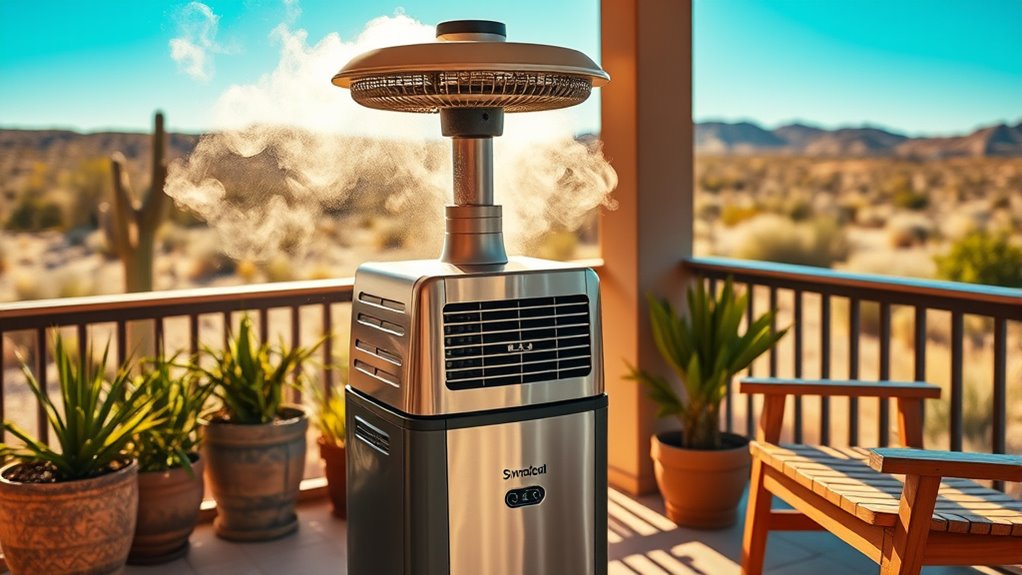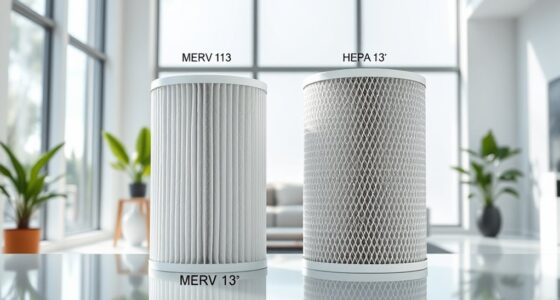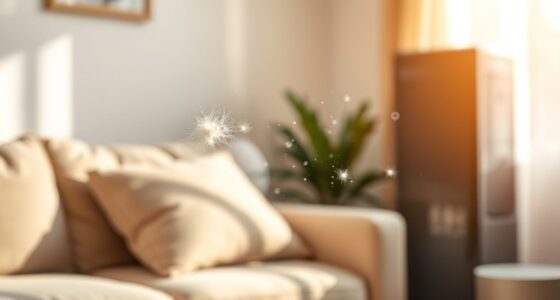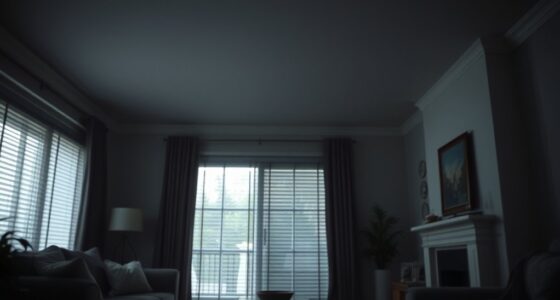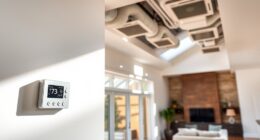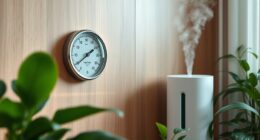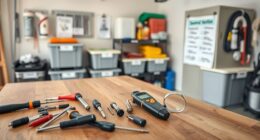Evaporative coolers, or swamp coolers, work best in dry, hot climates where they use water-saturated pads to naturally cool your indoor air through evaporation. They consume much less energy than air conditioners, making them cost-effective and eco-friendly. These coolers also add humidity, which is great for dry environments, but need proper ventilation and water maintenance for ideal performance. If you want to understand when and how swamp coolers shine, keep exploring this useful technology.
Key Takeaways
- Evaporative coolers are most effective in dry, hot climates with low humidity, where evaporation can efficiently cool the air.
- They work by drawing warm, dry air through water-saturated pads, cooling it naturally through evaporation before entering your space.
- Ideal for environments needing moisture addition, they provide cooling while increasing indoor humidity in arid conditions.
- Proper sizing, water cleanliness, and adequate ventilation are essential to maximize cooling performance and efficiency.
- They are a cost-effective, energy-efficient alternative to traditional air conditioners, especially in suitable dry climates.
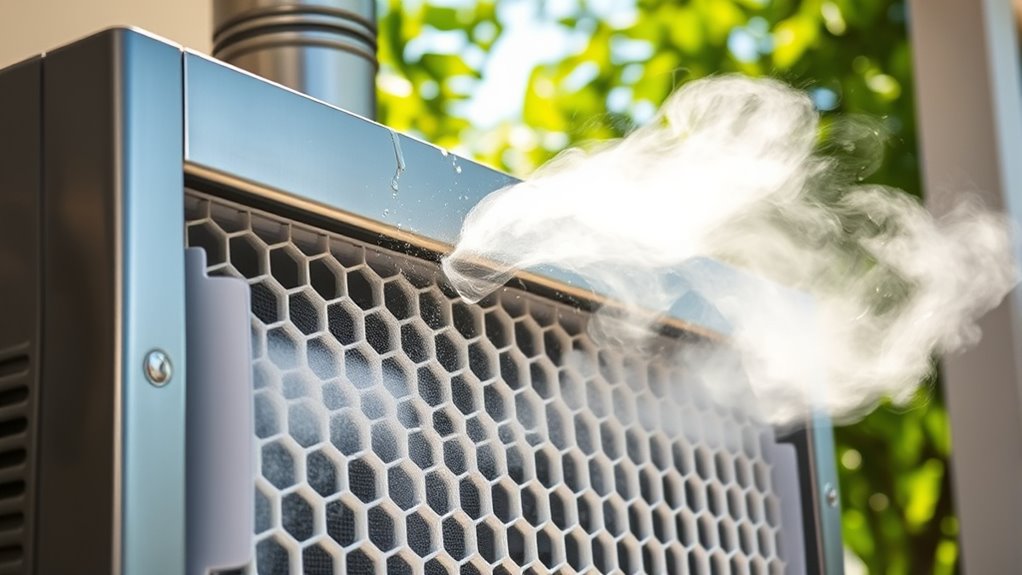
If you’re looking for an energy-efficient way to cool your home, an evaporative cooler might be the perfect solution. These devices work by drawing warm air through water-saturated pads, where the air is cooled by evaporation before entering your living space. Unlike traditional air conditioners, evaporative coolers use considerably less electricity because they rely on the natural process of water evaporation rather than compressors and refrigerants. This makes them a cost-effective and environmentally friendly cooling option, especially in dry, hot climates.
One of the key advantages of evaporative coolers is their ability to provide moisture control. Unlike central air conditioning systems that can dry out the air, swamp coolers introduce humidity into your home, which can make the environment feel more comfortable in arid conditions. This added moisture helps prevent the dry, itchy skin and irritated sinuses often associated with air-conditioned spaces. However, it’s vital to monitor indoor humidity levels; too much moisture can lead to issues like mold growth or discomfort, especially in more humid environments. Proper ventilation is imperative, as evaporative coolers require a steady airflow to operate efficiently and maintain ideal moisture levels.
Energy efficiency is arguably the standout feature of evaporative coolers. Because they don’t rely on refrigerants or complex electrical components, they consume far less power than traditional air conditioning units. When you run an evaporative cooler, you’re only powering a fan and a water pump, both of which use minimal electricity. As a result, you’ll see lower energy bills and a smaller carbon footprint. This makes evaporative cooling particularly appealing if you’re seeking sustainable ways to stay cool during the hot months. Additionally, because they are simpler in design, they tend to be easier to maintain and repair, further reducing long-term costs.
The effectiveness of evaporative coolers is most noticeable in dry climates, where the air’s low humidity enhances the cooling process. They work best when outdoor air is hot and dry, allowing the water to evaporate quickly and cool the air efficiently. In more humid regions, their performance diminishes because the air already contains a lot of moisture, making evaporation less effective. To maximize their benefits, you should ensure proper sizing for your space, keep the water clean, and provide adequate ventilation for air exchange. When used correctly, evaporative coolers offer a natural, energy-efficient way to keep your home comfortable without the downsides of traditional air conditioning.
Frequently Asked Questions
How Often Should I Replace the Cooling Pads?
You should replace your cooler pads every 1 to 3 years, depending on your maintenance schedule and the pads’ condition. Regularly inspect them for signs of mold, mineral buildup, or deterioration. Proper cooler pad replacement is essential for efficient cooling and preventing mold growth. Incorporate this into your maintenance schedule, and change the pads sooner if they show significant wear, ensuring your swamp cooler stays effective and clean.
Can Evaporative Coolers Be Used in Humid Climates?
Using an evaporative cooler in a humid climate is like trying to cool air with a damp cloth—you might find it less effective. Humid conditions reduce the cooler’s ability to evaporate water, which is key to its cooling power. So, if your area’s humidity levels are high, a swamp cooler might not be the best choice, and you’ll want to contemplate other cooling options for better efficiency.
What Maintenance Is Required for Long-Term Use?
For long-term use, you need to regularly check and replace the water filtration to prevent mineral buildup and guarantee clean airflow. Keep an eye on the pump, cleaning and maintaining it to avoid clogs or failure. Also, inspect and clean the pads seasonally, and ensure the water supply is consistent. Proper maintenance helps your evaporative cooler run efficiently and extends its lifespan.
Are Swamp Coolers Energy-Efficient Compared to Air Conditioners?
Swamp coolers are generally 50-75% more energy-efficient than traditional air conditioners, saving you significant energy costs. This efficiency not only reduces your electricity bills but also offers environmental benefits by lowering your carbon footprint. You’ll notice that evaporative coolers use less power and require less maintenance, making them a smart choice for sustainable living and long-term energy savings.
How Noisy Are Evaporative Coolers During Operation?
Evaporative coolers are generally quieter than traditional air conditioners, with low noise levels during operation. You’ll mostly hear the gentle hum of the fan and the soft sound of water moving through the system, which are usually unobtrusive. Operational sounds are minimal, making swamp coolers a good choice for quiet environments. If noise levels are a concern, you’ll appreciate their peaceful operation compared to the louder compressors of standard AC units.
Conclusion
Now that you know the ins and outs of swamp coolers, you can decide if they’re right for your home. These efficient, eco-friendly coolers excel in dry climates and can save you money on energy bills. Remember, “A penny saved is a penny earned,” and choosing the right cooling system can make all the difference. With proper maintenance, your evaporative cooler will keep you comfortable while being kind to the environment.
